8+ Review of Systems Examples to Download
In today’s digital age, the use of efficient tools for documentation and analysis has become paramount. When it comes to conducting a comprehensive Review of Systems, software applications such as Google Docs, Word, and PDF offer valuable features that can streamline the process. In this article, we will explore the benefits of utilizing these platforms and provide you with a step-by-step guide to performing a Review of Systems seamlessly. Additionally, we will address some common FAQs to ensure a thorough understanding of this essential task.
1. Free Review of Systems
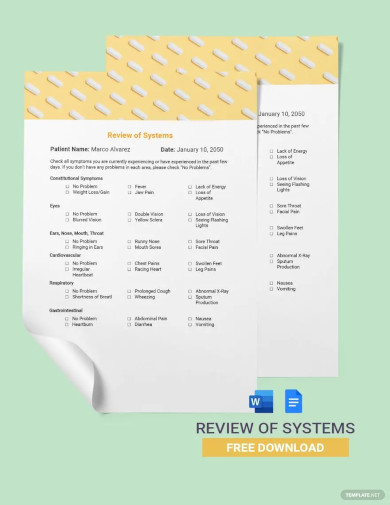
2. Review of Systems Template
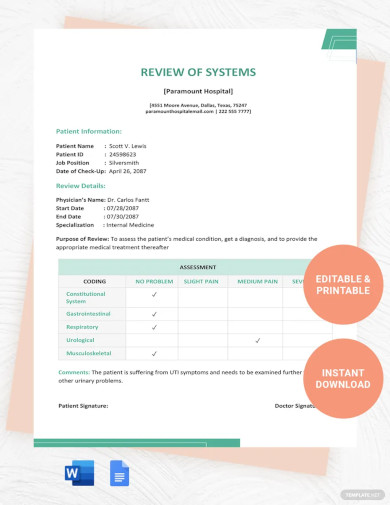
3. Review of Systems Medical History Taking
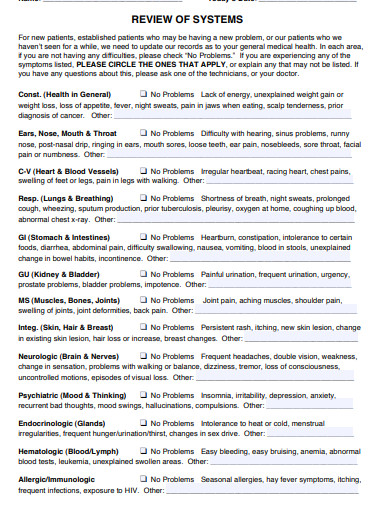
shulmaneye.com
4. Nursing Review of Systems

dignityhealth.org
5. Psychiatric Nursing Review of Systems
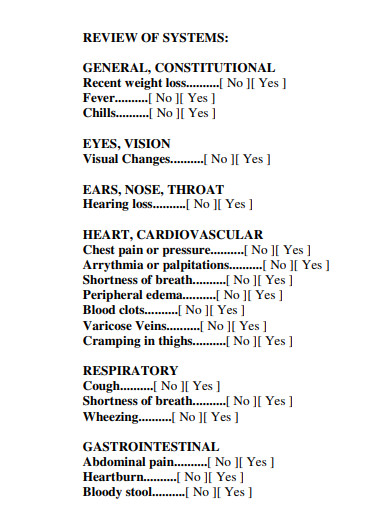
upmc.com
6. Gynecology Review of Systems
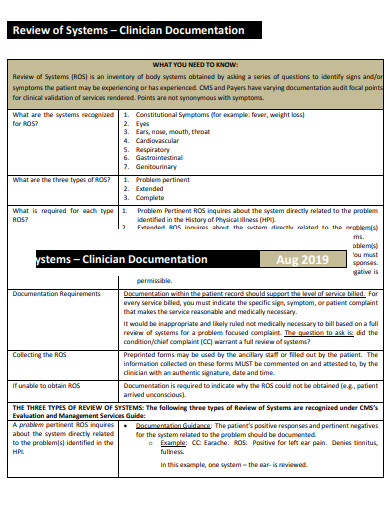
vumc.org
7. Obstetrics Review of Systems
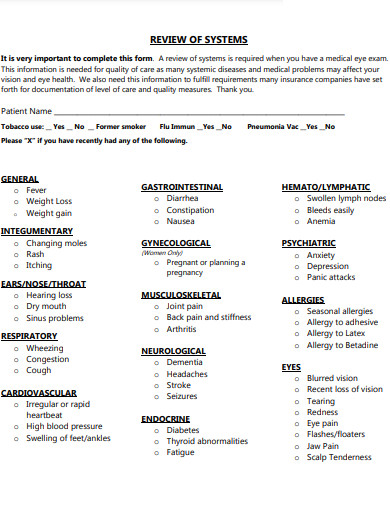
mountaineye.org
8. Eye Exam Review of Systems
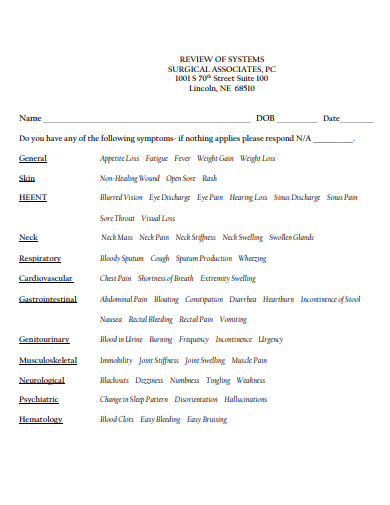
surgicalassociatespc.net
9. Symptoms of Review of Systems
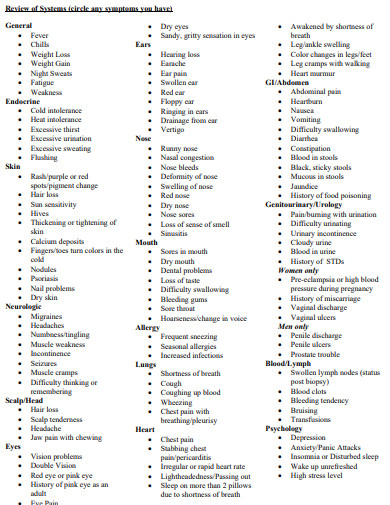
health.maryland.gov
What is a Review System?
A Review of Systems is a systematic and structured approach used to assess various aspects of a particular system, process, or organization. It involves a comprehensive evaluation of different components and functionalities, aiming to identify strengths, weaknesses, and areas that require improvement. By conducting a Review of Systems, individuals, and businesses can gain valuable insights into their operations and make informed decisions for adaptation and optimization.
How to perform a Review of Systems
Performing a Review of Systems may seem like a daunting task, but with the right approach and tools, it can be an efficient and effective process. Here’s a step-by-step guide to help you navigate through the review seamlessly.
Step 1: Define the Scope:
Before diving into the review, clearly define the scope of the system or process you are examining. Determine the objectives, boundaries, and specific areas to focus on during the assessment.
Step 2: Gather Relevant Information:
Collect all necessary documents, reports, and data related to the system under review. This may include performance worksheets, business systems analysis examples, site plans, mind mapping diagrams, summary reports, validation reports, and workflow charts.
Step 3: Identify Strengths and Weaknesses:
Systematically analyze the gathered information to identify the strengths and weaknesses within the reviewed system. Look for positive aspects such as adaptation, efficient workflow, and effective communication, as well as negative feedback and areas that require improvement.
Step 4: Document Findings:
Record all your observations and findings in a structured manner. Utilize tools like Google Docs, Word, or PDF to create a comprehensive report, ensuring clarity, organization, and easy accessibility of information.
Step 5: Develop an Action Plan:
Based on your findings, create an action plan outlining the necessary steps to address the identified weaknesses and enhance the system’s strengths. Include specific recommendations, timelines, and responsible parties for each action item.
FAQs
What are the benefits of conducting a Review of Systems?
A Review of Systems allows individuals and organizations to gain a comprehensive understanding of their operations. It helps identify areas for improvement, enhance efficiency, streamline workflows, and make informed decisions for optimal performance.
Can I perform a Review of Systems on my own?
While it is possible to conduct a Review of Systems individually, involving a team or external experts can bring valuable insights and diverse perspectives. Collaboration fosters a more comprehensive evaluation and facilitates the identification of blind spots.
How often should a Review of Systems be performed?
The frequency of conducting a Review of Systems varies depending on the nature of the system or process being assessed. Generally, it is recommended to perform regular reviews, whether quarterly, annually, or as significant changes occur, to ensure continuous improvement and adaptability.
In conclusion, performing a Review of Systems is crucial for optimizing performance and ensuring efficient workflows. By leveraging the features of Google Docs, Word, and PDF, individuals and businesses can streamline the review process and generate comprehensive reports for informed decision-making. Embracing this systematic approach empowers organizations to adapt, grow, and thrive in today’s ever-evolving landscape.
8+ Review of Systems Examples to Download

In today’s digital age, the use of efficient tools for documentation and analysis has become paramount. When it comes to conducting a comprehensive Review of Systems, software applications such as Google Docs, Word, and PDF offer valuable features that can streamline the process. In this article, we will explore the benefits of utilizing these platforms and provide you with a step-by-step guide to performing a Review of Systems seamlessly. Additionally, we will address some common FAQs to ensure a thorough understanding of this essential task.
1. Free Review of Systems

Details
File Format
Google Docs
Word
PDF
2. Review of Systems Template

Details
File Format
Google Docs
PDF
Word
3. Review of Systems Medical History Taking

shulmaneye.com
Details
File Format
PDF
Size: 54 KB
4. Nursing Review of Systems

dignityhealth.org
Details
File Format
PDF
Size: 48 KB
5. Psychiatric Nursing Review of Systems

upmc.com
Details
File Format
PDF
Size: 10 KB
6. Gynecology Review of Systems

vumc.org
Details
File Format
PDF
Size: 125 KB
7. Obstetrics Review of Systems

mountaineye.org
Details
File Format
PDF
Size: 78 KB
8. Eye Exam Review of Systems

surgicalassociatespc.net
Details
File Format
PDF
Size: 45 KB
9. Symptoms of Review of Systems

health.maryland.gov
Details
File Format
PDF
Size: 11 KB
What is a Review System?
A Review of Systems is a systematic and structured approach used to assess various aspects of a particular system, process, or organization. It involves a comprehensive evaluation of different components and functionalities, aiming to identify strengths, weaknesses, and areas that require improvement. By conducting a Review of Systems, individuals, and businesses can gain valuable insights into their operations and make informed decisions for adaptation and optimization.
How to perform a Review of Systems
Performing a Review of Systems may seem like a daunting task, but with the right approach and tools, it can be an efficient and effective process. Here’s a step-by-step guide to help you navigate through the review seamlessly.
Step 1: Define the Scope:
Before diving into the review, clearly define the scope of the system or process you are examining. Determine the objectives, boundaries, and specific areas to focus on during the assessment.
Step 2: Gather Relevant Information:
Collect all necessary documents, reports, and data related to the system under review. This may include performance worksheets, business systems analysis examples, site plans, mind mapping diagrams, summary reports, validation reports, and workflow charts.
Step 3: Identify Strengths and Weaknesses:
Systematically analyze the gathered information to identify the strengths and weaknesses within the reviewed system. Look for positive aspects such as adaptation, efficient workflow, and effective communication, as well as negative feedback and areas that require improvement.
Step 4: Document Findings:
Record all your observations and findings in a structured manner. Utilize tools like Google Docs, Word, or PDF to create a comprehensive report, ensuring clarity, organization, and easy accessibility of information.
Step 5: Develop an Action Plan:
Based on your findings, create an action plan outlining the necessary steps to address the identified weaknesses and enhance the system’s strengths. Include specific recommendations, timelines, and responsible parties for each action item.
FAQs
What are the benefits of conducting a Review of Systems?
A Review of Systems allows individuals and organizations to gain a comprehensive understanding of their operations. It helps identify areas for improvement, enhance efficiency, streamline workflows, and make informed decisions for optimal performance.
Can I perform a Review of Systems on my own?
While it is possible to conduct a Review of Systems individually, involving a team or external experts can bring valuable insights and diverse perspectives. Collaboration fosters a more comprehensive evaluation and facilitates the identification of blind spots.
How often should a Review of Systems be performed?
The frequency of conducting a Review of Systems varies depending on the nature of the system or process being assessed. Generally, it is recommended to perform regular reviews, whether quarterly, annually, or as significant changes occur, to ensure continuous improvement and adaptability.
In conclusion, performing a Review of Systems is crucial for optimizing performance and ensuring efficient workflows. By leveraging the features of Google Docs, Word, and PDF, individuals and businesses can streamline the review process and generate comprehensive reports for informed decision-making. Embracing this systematic approach empowers organizations to adapt, grow, and thrive in today’s ever-evolving landscape.

